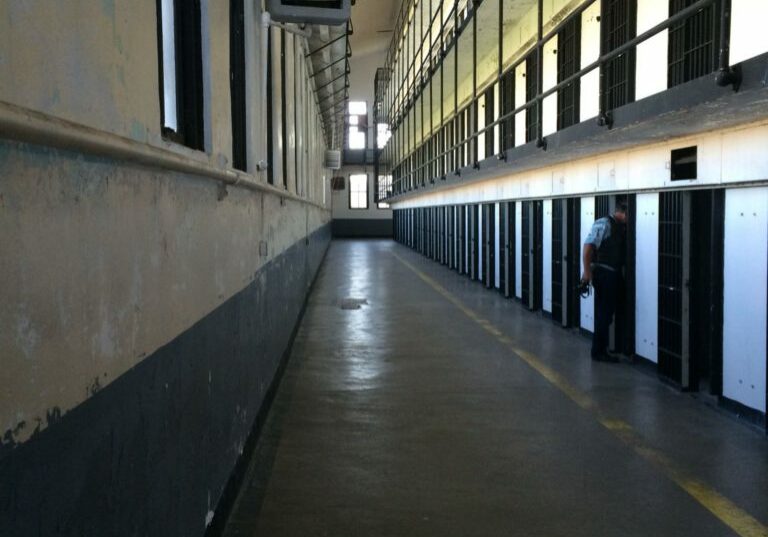The First Step Act: All Your Questions Explained
On May 9, 2018, the House Judiciary Committee passed a bipartisan federal prison reform bill known as the First Step Act (H.R. 5682). The bill’s longer name is the “Formerly Incarcerated Reenter Society Transformed Safely Transitioning Every Person Act.” The First Step Act was previously called the Prison Reform and Redemption Act.
Before the First Step Act can become law, it must be passed out of the House of Representatives and voted on in the Senate. Then the President must sign it.
The bill is expected to receive a floor vote in the House by the end of May 2018. The bill’s fate in the Senate remains promising, but some activists oppose the First Step Act because it does not include sentencing reforms.

First Step Act Federal Prison Reform
Here are key points about the First Step Act:
1. The First Step Act Requires The Development Of A Risk And Needs Assessment System
Within 180 days after the First Step Act becomes law, the Attorney General is required to develop a “Risk and Needs Assessment System.” The system will gauge individual prisoner recidivism risk, and help Bureau of Prisons (BOP) staff decide which recidivism reduction programs individuals should participate in. After the system has been developed, the BOP has 180 days to begin implementation. Priority for program participation will be given to prisoners, at least initially, who are within two years of release.
All of the recidivism reduction programs contemplated by the First Step Act must be “evidence based.”
Further, the First Step Act allows the BOP to “use existing risk and needs assessment tools, as appropriate.” The BOP previously developed a risk and needs assessment tool called the “Inmate Skills Development System” (ISDS). But the BOP has been phasing out ISDS in anticipation of the rollout of “Insight,” a new program that “will enable institutions to better track an inmate’s progress in correctional programming and will allow subject matter experts to include feedback about the inmate.”1
I expect the BOP to likely use “Insight,” or whatever new name the BOP may give to that system, as the “Risk and Needs Assessment System” required by the First Step Act.
2. The First Step Act Provides Incentives For Prisoner Participation In Recidivism Reduction Programs
The First Step Act offers incentives to prisoners to participate in recidivism reduction programs.
Those incentives include:
“phone privileges, or, if available, video conferencing privileges, for up to 30 minutes per day, and up to 510 minutes per month”;
- “additional time for visitation at the prison, as determined by the warden of the prison”;
- “placement in a facility closer to the prisoner’s release residence” subject to the availability of bed space, the security level of the facility, and the Warden’s support for the requested transfer;
- “Increased commissary spending limits and product offerings”;
- “Extended opportunities to access the email system”;
- “Consideration of transfer to preferred housing units (including transfer to different prison facilities)”;
- “Other incentives solicited from prisoners and determined appropriate by the Director”
3. First Step Act Also Offers Prisoners The Opportunity To Spend Longer Amounts Of Time In Pre-Release Custody Through The Accumulation Of Time Credits
Eligible prisoners who participate in “recidivism reduction programming” or “productive activities” can receive “time credits” that increase the amount of time a prisoner spends in pre-release custody in either a halfway house or on home confinement. The amount of time credits that can be earned under the First Step Act federal prison reform bill are as follows:
- A prisoner shall earn 10 days of time credits for every 30 days of successful participation in evidence-based recidivism reduction programming or productive activities;
- A prisoner determined by the Bureau of Prisons to be at a minimum or low risk for recidivating, who, over two consecutive assessments, has not increased their risk of recidivism, shall earn an additional 5 days of time credits for every 30 days of successful participation in evidence-based recidivism reduction programming or productive activities.
Programs taken before passage of the First Step Act do not qualify for time credits.
Once a prisoner has “been determined to be at minimum risk or low risk for recidivating pursuant to their last two reassessments,” the accumulated time credits may be used to transfer the prisoner to pre-release custody.
The Director of the BOP may only deny an eligible prisoner’s transfer to pre-release custody if the Warden “if the warden of the prison finds by clear and convincing evidence that the prisoner should not be transferred into prerelease custody based only on evidence of the prisoner’s actions after the conviction of such prisoner and not based on evidence from the underlying conviction, and submits a detailed written statement regarding such finding to the Director of the Bureau of Prisons.”
Pre-release custody may be spent on home confinement or in a Residential Reentry Center, more commonly known as a federal halfway house
4. The First Step Act Fixes The “54 Day” Problem With Federal Good Conduct Time
In addition to allowing federal prisoners the opportunity to spend longer amounts of time in pre-release custody, the First Step Act federal prison reform fixes a longstanding problem with how federal good conduct time is calculated.
Under existing law, federal prisoners who maintain good conduct can receive a reduction equal to 47 days a year for each year of imprisonment that was imposed. The existing statute requires the BOP to award 54 days of good conduct time, but the BOP interprets the current statute as requiring prisoners to fully serve a year before earning the 54 days. The Supreme Court in Barber v. Thomas, 560 U.S. 474 (2010) upheld the BOP’s interpretation of the current good time law.
The First Step Act requires the BOP to award 54 days of good conduct time for each year of the sentence that was imposed. Thus, a ten year sentence would equal to 540 possible days of good conduct time.
In addition, the First Step Act changes the way prorated good conduct time is credited. Under the First Step Act, “credit for the last year of a term of imprisonment shall be credited on the first day of the last year of the term of imprisonment.”
These changes would apply immediately once the law is enacted. It is expected that 4,000 BOP prisoners would be subject to immediate release if the good time component of the law passes.
5. Non Citizens Can Participate In Recidivism Reduction Programs And Productive Activities Under the First Step Act
Prisoners subject to deportation are eligible to receive time credits that accelerate their release to pre-release custody, just like U.S. citizens. However, rather than being transferred to a halfway house or home confinement in the United States, prisoners facing deportation would be turned over to ICE for deportation.
6. The First Step Act Bars The Shackling Of Pregnant Prisoners
The First Step Act also formally bars the BOP from generally using “restraints on prisoners during the period of pregnancy, labor, and postpartum recovery prohibited.”
7. The First Step Act Requires The BOP To Keep Prisoners Closer To Their Families
The First Step Act federal prison reform also requires the BOP to keep prisoners closer to their family members. The law changes 18 U.S.C. 3621 by requiring the BOP to “designate the place of the prisoner’s imprisonment, and shall, subject to bed availability, the prisoner’s security designation, the prisoner’s programmatic needs, and the prisoner’s mental and medical health needs, place the prisoner in a facility as close as practicable to the prisoner’s primary residence, but, in any case, not more than 500 driving miles from the prisoner’s primary residence. Subject to bed availability and the prisoner’s security designation, the Bureau shall transfer prisoners to facilities that are closer to the prisoner’s primary residence even if the prisoner is already in a facility within 500 driving miles of that residence, unless the prisoner chooses to remain at his or her current facility.’’
8. The First Step Act Changes The Way Compassionate Release Requests Are Applied For
Under existing law, only the Director of the BOP can move for a defendant’s release on compassionate release grounds. The First Step Act changes this by allowing prisoners to motion for compassionate release from the Court after exhausting administrative remedies. The motion may also be filed by the prisoner if the Warden fails to respond to a request for compassionate release within 30 days.
9. The First Step Act Requires The BOP To Assist Prisoners In Obtaining Identification
The First Step Act amends 18 U.S.C. 4042 by requiring the BOP to help prisoners obtain “obtain identification, including a social security card, driver’s license or other official photo identification, and a birth certificate.”
10. The First Step Act Expands Who UNICOR Can Sell To
The First Step Act grants Federal Prison Industries, commonly known as UNICOR, wider authority to sell to different entities. This expanded authority is intended to create greater work opportunities for federal prisoners. The First Step Act further directs that at least 15 percent a prisoner’s UNICOR wages be held in a special fund for the prisoner’s use upon release.
11. Other Miscellaneous Changes
The First Step Act also makes other changes, such as requiring the BOP to provide tampons and sanitary napkins to female prisoners at no cost. The bill also requires the BOP to pilot mentorship programs between young prisoners and members of the community, which may include formerly incarcerated persons.
12. The First Step Act Excludes A Wide Array Of Prisoners From Earning Pre-release Time Credits
Unfortunately, the First Step Act excludes a large number of offenders from earning pre-release time credits. Any person serving a sentence for a violation of the following are excluded:
‘‘(i) Section 113(a)(1), relating to assault with intent to commit murder.
‘‘(ii) Section 115, relating to influencing, impeding, or retaliating against a Federal official by injuring a family member, except for a threat made in violation of that section.
‘‘(iii) Any section of chapter 10, relating to biological weapons.
‘‘(iv) Any section of chapter 11B, relating to chemical weapons.
‘‘(v) Section 351, relating to Congressional, Cabinet, and Supreme Court assassination, kidnapping, and assault.
‘‘(vi) Section 793, relating to gathering, transmitting, or losing defense information.
‘‘(vii) Section 794, relating to gathering or delivering defense information to aid a foreign government.
‘‘(viii) Any section of chapter 39, relating to explosives and other dangerous articles, except for section 836 (relating to the transportation of fireworks into a State prohibiting sale or use).
‘‘(ix) Section 842(p), relating to distribution of information relating to explosive, destructive devices, and weapons of mass destruction, but only if the conviction involved a weapon of mass destruction (as defined section 2332a(c)(2) of such title).
‘‘(x) Subsection (f)(3), (h), or (i) of section 844, relating to the use of fire or an explosive.
‘(xi) Section 924(e), relating to unlawful possession of a firearm by a person with 3 or more convictions for a violent felony.
‘(xii) Section 1030(a)(1), relating to fraud and related activity in connection with computers.
‘‘(xiii) Any section of chapter 51, relating to homicide, except for section 1112 (relating to manslaughter), 1113 (relating to attempt to commit murder or manslaughter, but only if the conviction was for an attempt to commit manslaughter), 1115 (relating to misconduct or neglect of ship officers), or 1122 (relating to protection against the human immunodeficiency virus).
‘‘(xiv) Any section of chapter 55, relating to kidnapping.
‘‘(xv) Any offense under chapter 77, relating to peonage, slavery and trafficking in persons, except for sections 1592 through 1596.
‘‘(xvi) Section 1751, relating to Presidential and Presidential staff assassination, kidnapping, and assault.
‘‘(xvii) Section 1841(a)(2)(C), relating to intentionally killing or attempting to kill an unborn child.
‘‘(xviii) Section 1992, relating to terrorist attacks and other violence against railroad carriers and against mass transportation systems on land, on water, or through the air.
‘‘(xix) Section 2113(e), relating to bank robbery resulting in death.
‘‘(xx) Section 2118(c)(2), relating to robberies and burglaries involving controlled substances resulting in death.
‘(xxi) Section 2119(3), relating to taking a motor vehicle (commonly referred to as ‘carjacking’) that results in death.
‘‘(xxii) Any section of chapter 105, relating to sabotage, except for section 2152.
‘‘(xxiii) Any section of chapter 109A, relating to sexual abuse, except that with regard to section 2244, only a conviction under subsection (c) of that section (relating to abusive sexual contact involving young children) shall make a prisoner ineligible under this subparagraph.
‘‘(xxiv) Section 2251, relating to the sexual exploitation of children.
‘‘(xxv) Section 2251A, relating to the selling or buying of children.
‘‘(xxvi) Any of paragraphs (1) through (3) of section 2252(a), relating to certain activities relating to material involving the sexual exploitation of minors.
‘‘(xxvii) A second or subsequent conviction under any of paragraph (1) through (6) of section 2252A(a), relating to certain activities relating to material constituting or containing child pornography.
‘‘(xxviii) Section 2260, relating to the production of sexually explicit depictions of a minor for importation into the United States.
‘‘(xxix) Section 2283, relating to the transportation of explosive biological, chemical, or radioactive or nuclear materials.
‘‘(xxx) Section 2284, relating to the transportation of terrorists.
‘‘(xxxi) Section 2291, relating to the destruction of a vessel or maritime facility, but only if the conduct which led to the conviction involved a substantial risk of death or serious bodily injury.
‘‘(xxxii) Any section of chapter 113B, relating to terrorism.
‘‘(xxxiii) Section 2340A, relating to torture.
‘‘(xxxiv) Section 2381, relating to treason.
‘‘(xxxv) Section 2442, relating to the recruitment or use of child soldiers.
‘‘(xxxvi) Section 57(b) of the Atomic Energy Act of 1954 (42 U.S.C. 2077(b)), relating to the engagement or participation in the development or production of special nuclear material.
‘‘(xxxvii) Section 92 of the Atomic Energy Act of 1954 (42 U.S.C. 2122), relating to prohibitions governing atomic weapons.
‘‘(xxxviii) Section 101 of the Atomic Energy Act of 1954 (42 U.S.C. 2131), relating to the atomic energy license requirement.
‘‘(xxxix) Section 224 or 225 of the Atomic Energy Act of 1954 (42 U.S.C. 2274, 2275), relating to the communication or receipt of restricted data.
‘‘(xl) Section 236 of the Atomic Energy Act of 1954 (42 U.S.C. 2284), relating to the sabotage of nuclear facilities or fuel.
‘‘(xli) Section 60123(b) of title 49, United States Code, relating to damaging or destroying a pipeline facility, but only if the conduct which led to the conviction involved a substantial risk of death or serious bodily injury.
‘‘(xlii) Section 401(a) of the Controlled Substances Act (21 U.S.C. 841), relating to manufacturing or distributing a controlled substance, but only in the case of a conviction for an offense described in Subparagraph (A), (B), or (C) of subsection (b)(1) of that section for which death or serious bodily injury resulted from the use of such substance.
‘‘(xliii) Section 276(a) of the Immigration and Nationality Act (8.U.S.C. 1326), relating to the reentry of a removed alien, but only if the alien is described in paragraph (1) or (2) of subsection (b) of that section.
‘‘(xliv) Any section of the Export Administration Act of 1979 (50 U.S.C. App. 2401 et seq.)
‘‘(xlv) Section 206 of the International Emergency Economic Powers Act (50 U.S.C. 1705).
‘‘(xlvi) Section 601 of the National Security Act of 1947 (50 U.S.C. 3121), relating to the protection of identities of certain United States undercover intelligence officers, agents, informants, and sources.
‘‘(xlvii) An offense described in section 3559(c)(2)(F), for which the offender was sentenced to a term of imprisonment of more than one year, if the offender has a previous conviction, for which the offender served a term of imprisonment of more than one year, for a Federal or State offense, by whatever designation and wherever committed, consisting of murder (as described in section 1111), voluntary manslaughter (as described in section 1112), assault with intent to commit murder (as described in section 113(a)), aggravated sexual abuse and sexual abuse (as described in sections 2241 and 2242), abusive sexual contact (as described in sections 2244(a)(1) and (a)(2)), kidnapping (as described in chapter 55), carjacking (as described in section 2119), arson (as described in section 844(f)(3), (h), or (i)), or terrorism (as described in chapter 113B).
Download Our First Step Act Guide
If you would like to download or print a copy of this, please click here: First Step Act Guide.
You can also read our First Step Act FAQ here.
Recommended for you
MVRA Restitution And Loss Amount Inadequate, Eleventh Circuit Holds
United States v. Mitchell J. Stein : Mitchell Stein, a former attorney, challenged the district court’s loss and MVRA restitution determination in a mail, wire, and securities fraud prosecution arguing that the Government had failed to demonstrate both factual and legal causation for the loss amount.Using the same standard for Stein’s loss and restitution challenge,…
Career Offender Enhancement Cannot Be Based On Texas Possession With Intent To Distribute Conviction
United States v. Tanksley – Career Offender Enhancement : Dantana Tanksley was previously convicted in Texas under Section 481.112(a) of the Texas controlled substances act of possessing with intent to distribute a controlled substance. He was later enhanced as a career offender under federal sentencing guidelines. Under the federal sentencing guidelines, an individual can be…
Attorney Abandonment Claim Remanded For A Hearing
Mark Christeson filed a motion to re-open his habeas proceedings under Rule 60(b) arguing that his attorney’s failure to timely submit his 28 U.S.C. § 2254 petition (used by state prisoners but similar to a 2255) constituted attorney abandonment. The abandonment issue was key to resolving whether “extraordinary circumstances” existed to warrant granting Rule 60…




